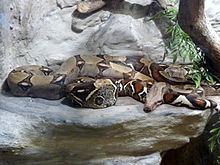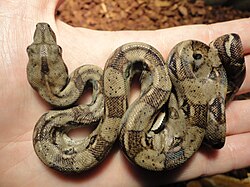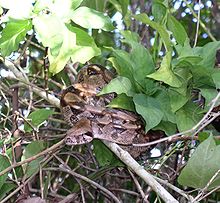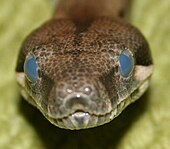| Boa constrictor | |
|---|---|
 | |
The boa constrictor (Boa constrictor), also called the red-tailed boa or the common boa, is a species of large, non-venomous, heavy-bodied snake that is frequently kept and bred in captivity.[2] The boa constrictor is a member of the family Boidae, found in tropical North, Central, and South America, as well as some islands in the Caribbean. A staple of private collections and public displays, its color pattern is highly variable yet distinctive. Ten subspecies are currently recognized, although some of these are controversial.[3]This article focuses on the species Boa constrictor as a whole, and on the nominate subspecies B. c. constrictor.
...Common names[edit]
Though all boids are constrictors, only this species is properly referred to as a "boa constrictor" – a rare instance of an animal having the same common English name and scientific binomial name.
All subspecies are referred to as "boa constrictors", while the nominate subspecies, B. c. constrictor, is often referred to specifically as the "red-tailed boa". Within the exotic pet trade, it is also known as a "BCC", an abbreviation of its scientific name, to distinguish it from other boa constrictor subspecies such as B. c. imperator, which is also regularly, and erroneously, referred to as a "red-tailed boa" or "common boa".
Other common names include chij-chan (Mayan),[4] jiboia (Latin American), and macajuel(Trinidadian).[5]
Description[edit]
Size and weight[edit]
The boa constrictor is a large snake, although it is only modestly sized in comparison to other large snakes, such as the reticulated python and Burmese python, and can reach lengths from 3–13 ft (0.91–3.96 m) depending on the locality and the availability of suitable prey.[6]Clear sexual dimorphism is seen in the species, with females generally being larger in both length and girth than males. The usual size of mature female boas is between 7 and 10 ft (2.1 and 3.0 m) whereas males are 6 and 8 ft (1.8 and 2.4 m).[7] Females commonly exceed 10 ft (3.0 m), particularly in captivity, where lengths up to 12 ft (3.7 m) or even 14 ft (4.3 m) can be seen.[8] The largest documented non-stretched dry skin is deposited at Zoologische Staatssammlung München (ZSM 4961/2012) and measures 14.6 ft (4.45 m) without head.[9] A report of a boa constrictor growing up to 18.5 ft (5.6 m) was later found to be a misidentified green anaconda.[10]
The boa constrictor is a heavy-bodied snake, and large specimens can weigh up to 27 kg (60 lb). Females, the larger sex, more commonly weigh 10 to 15 kg (22 to 33 lb).[11] Some specimens of this species can reach or possibly exceed 45 kg (100 lb), although this is not usual.[12]
The size and weight of a boa constrictor depends on subspecies, locale, and the availability of suitable prey. Several populations of boa constrictors are known as "dwarf boas", such as the population of B. c. imperator on Hog Island. These smaller subspecies are generally insular populations. B. c. constrictor reaches, and occasionally tops, the averages given above, as it is one of the relatively large subspecies of Boa constrictor.[7]
Other examples of sexual dimorphism in the species include males generally having longer tails to contain the hemipenes and also longer pelvic spurs, which are used to grip and stimulate the female during copulation.[13] Pelvic spurs are the only external sign of the rudimentary hind legs and pelvis, seen in all boas and pythons.
Coloring[edit]
The coloring of boa constrictors can vary greatly depending on the locality. However, they are generally a brown, grey, or cream base color, patterned with brown or reddish-brown "saddles" that become more pronounced towards the tail. This coloring gives B. c. constrictor the common name of "red-tailed boa", as it typically has more red saddles than other B. constrictor subspecies. The coloring works as very effective camouflage in the jungles and forests of its natural range.
Also, some individuals exhibit pigmentary disorders, such as albinism. Although these individuals are rare in the wild, they are common in captivity, where they are often selectively bred to make a variety of different color "morphs". Boa constrictors have an arrow-shaped head with very distinctive stripes on it: One runs dorsally from the snout to the back of the head; the others run from the snout to the eyes and then from the eyes to the jaw.[7]
Boa constrictors can sense heat via cells in their lips, though they lack the labial pits surrounding these receptors seen in many members of the family Boidae.[14] Boa constrictors also have two lungs, a smaller (nonfunctional) left and an enlarged (functional) right lung to better fit their elongated shape, unlike many colubrid snakes, which have completely lost the left lung.
Distribution and habitat[edit]
Depending on the subspecies, Boa constrictor can be found through Central America (Belize, Guatemala, Honduras, El Salvador, Nicaragua, Costa Rica, and Panama) to South America north of 35°S (Colombia, Ecuador, Peru, Venezuela, Trinidad and Tobago, Guyana, Suriname, French Guiana, Brazil, Bolivia, Uruguay, and Argentina), and in the Lesser Antilles (Dominica and St. Lucia), on San Andrés, Providencia and many other islands along the coasts of Mexico and Central and South America. An introduced population exists in extreme southern Florida,[15] and a small population on St. Croix in the US Virgin Islands now appears to be reproducing in the wild.[citation needed] The type locality given is "Indiis" – a mistake, according to Peters and Orejas-Miranda (1970).[1]
B. constrictor flourishes in a wide variety of environmental conditions, from tropical rainforests to arid semidesert country.[16]However, it prefers to live in rainforest due to the humidity and temperature, natural cover from predators, and vast amount of potential prey. It is commonly found in or along rivers and streams, as it is a very capable swimmer. Boa constrictors also occupy the burrows of medium-sized mammals, where they can hide from potential predators.[7]
Behavior[edit]
Boa constrictors generally live on their own, and do not interact with any other snakes unless they want to mate. They are nocturnal, but they may bask during the day when night-time temperatures are too low. As semi-arboreal snakes, young boa constrictors may climb into trees and shrubs to forage; however, they become mostly terrestrial as they become older and heavier.[17] Boa constrictors strike when they perceive a threat. Their bite can be painful, especially from large snakes, but is rarely dangerous to humans. Specimens from Central America are more irascible, hissing loudly and striking repeatedly when disturbed, while those from South America tame down more readily.[16] Like all snakes, boa constrictors in a shed cycle are more unpredictable, because the substance that lubricates between the old skin and the new makes their eyes appear milky, blue, or opaque, so that the snake cannot see very well, causing it to be more defensive than it might be otherwise.
Full Article.
Full Article.
Now This.







No comments:
Post a Comment